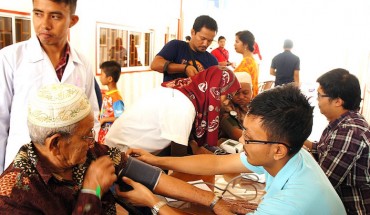Dr Li Wenliang, the Chinese doctor who first sounded the alarm on the Wuhan coronovirus, died from the disease at the age of 32, the image of his face complete with breathing tube was seen by millions of followers on social media. Apparently posted a few hours before his death on February 6 at 8.17pm, it showed him apparently alert, bright eyed, holding up his ID card from the hospital where he worked. He passed away at 2.58am on February 7, less than seven hours later, according to the People’s Daily newspaper in China.
Many doctors who saw this image found it strange – typically people with pneumonia who are close to death are drowsy and confused and even comatose. They are struggling to breathe with their lungs filling up with fluid, not posting pictures on the Chinese equivalent of Instagram.
A recent study – the first ever study to focus on coronovirus patients in Wuhan, published in JAMA, may provide a clue about how this virus causes death in around three per cent of cases. The doctors wrote that people with this infection who had been exposed at the Huanan Seafood Wholesale Market, had different symptoms including fever, non productive cough and fatigue. But they added, ‘Organ dysfunction (e.g. shock, acute respiratory distress syndrome (ARDS), acute cardiac injury and acute kidney injury) and death can occur in severe cases.’
Massive organ failure would explain rapid decline in a patient, seemingly alert on the threshold of death. Like sepsis, which can lead to organ failure and death within hours, the coronovirus could be triggering an immune response in the body when the patient’s own defences begin to attack vital organs. The coronovirus, which is an envelope type virus like SARS and HIV, invades cells and destroys them, taking over the membrane as a kind of invisibility shield. We know that it locks on to the ACE-2 receptor in the deep cells within the lungs as well as the cells of the lining of the small intestine, causing symptoms like flu and abdominal pains. But it could also be triggering a cascade of events, leading the immune system to damage other organs in the body such as the kidneys and heart.
If this is the case, not everyone would be susceptible, but those who were would include healthy young men like Dr Li Wenliang who was reportedly fit and well before he contracted the infection. It won’t just be a problem for the very old and the very young, like most cases of flu, but for all of us. There’s no cure for multiple organ failure triggered by the body’s own immune response. They tried to save Dr Li Wenliang by hooking him up to a ventilating machine that breathed for him, but in the end to no avail.
Standard surgical masks, which he wore while treating patients, are unlikely to have been much use either. The cloth masks shown allow viruses to penetrate through the material, especially when wet through breathing, and air is breathed in through the sides of the masks because they are not sealed. And although the virus is spread through droplets in the air which land on surfaces, it may also spread through faecal contamination and contact with the hand onto surfaces. My own research has found that coronovirus can survive for up to five days on worktops for example. The key thing is to take standard hygiene precautions such as washing hands and regularly disinfecting surfaces, and ensure that spread is minimised.’






